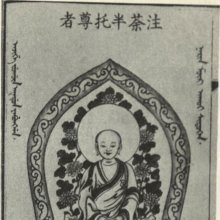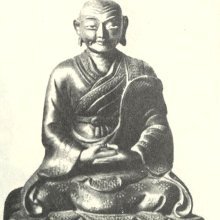Cudapanthaka, Cūḍapanthaka: 2 definitions
Introduction:
Cudapanthaka means something in Buddhism, Pali, Hinduism, Sanskrit. If you want to know the exact meaning, history, etymology or English translation of this term then check out the descriptions on this page. Add your comment or reference to a book if you want to contribute to this summary article.
Alternative spellings of this word include Chudapanthaka.
Images (photo gallery)
In Buddhism
Mahayana (major branch of Buddhism)
Source: Wisdom Library: Maha Prajnaparamita SastraCūḍapanthaka (चूडपन्थक) is the name of a Buddhist mentioned in the 2nd century Mahāprajñāpāramitāśāstra chapter 39. Mahāpanthaka and Cūḍapanthaka were born from the union of a wealthy young girl in Rājagṛha and a slave. They were born at the side of a great highway which is why they were named Great Path and Lesser Path respectively. Raised by their grandparents, they embraced the Buddhist faith. Mahāpanthaka was the first to become a monastic and, shortly thereafter, welcomed his brother into the Order. Entrusted with his religious instruction, he gave him a very simple stanza to learn by heart: “pāpaṃ na kuryān manasā na vācā, etc.”, but Cūḍapanthaka was so dim-witted (duṣprajñā) that at the end of three months, he had not yet succeeded in memorizing it.
The Avadāna also mentions an episode concerning the future Arhat. The day that Cūḍapanthaka became a monk, the famous physician Jīvaka invited the Buddha and the Saṃgha except for Cūḍapanthaka whom he deemed to be too stupid. The Buddha accepted the invitation, but noticing that the Saṃgha was not complete, he refused to partake of the meal.

Mahayana (महायान, mahāyāna) is a major branch of Buddhism focusing on the path of a Bodhisattva (spiritual aspirants/ enlightened beings). Extant literature is vast and primarely composed in the Sanskrit language. There are many sūtras of which some of the earliest are the various Prajñāpāramitā sūtras.
Languages of India and abroad
Sanskrit dictionary
Source: Cologne Digital Sanskrit Dictionaries: Edgerton Buddhist Hybrid Sanskrit DictionaryCūḍapanthaka (चूडपन्थक) or Culla-pantha or .—q.v.; so read in Sukhāvatīvyūha 2.11 for Culla-patka, a monstrous form for which, amazingly, there is no ms. authority, whereas one ms. (reading -patthena) obviously intends -panthena (instr.) as the note points out (two mss. omit the word; the fourth -pacchena, surely for -patthena = panthena).
--- OR ---
Cūḍapanthaka (चूडपन्थक).—(Cūla°, Cūḍā°; also Culla-pantha, Śuddhi-panthaka, qq.v.; = Pali Cūla°), name of a disciple of the Buddha: Cūḍa° Mahāvyutpatti 1054 (v.l. Cūla°; Mironov Cūḍa° only); Mūla-Sarvāstivāda-Vinaya i.206.4 ff.; Divyāvadāna 493.12 (in other places in Divyāvadāna called simply Panthaka, q.v.); Cūḍā° Karmavibhaṅga (and Karmavibhaṅgopadeśa) 43.1 (doubtless by error; v.l. Vṛddha-p°; not in Tibetan). The first element has nothing to do with cūḍā but means lesser, minor; he is contrasted with Mahā-panthaka Divyāvadāna 493.11, 12.
--- OR ---
Cūḍāpanthaka (चूडापन्थक).—see Cūḍap°.
--- OR ---
Cūḍapanthaka (चूडपन्थक) or Panthaka.—q.v. (younger brother of Mahā-p°): Divyāvadāna 485.28 ff.
Sanskrit, also spelled संस्कृतम् (saṃskṛtam), is an ancient language of India commonly seen as the grandmother of the Indo-European language family (even English!). Closely allied with Prakrit and Pali, Sanskrit is more exhaustive in both grammar and terms and has the most extensive collection of literature in the world, greatly surpassing its sister-languages Greek and Latin.
See also (Relevant definitions)
Partial matches: Panthaka, Cuda.
Full-text: Panthaka, Dvadashavargiya, Pantha, Cullapantha, Sthulaksha, Mahapanthaka.
Relevant text
Search found 3 books and stories containing Cudapanthaka, Cūḍapanthaka, Cuda-panthaka, Cūḍa-panthaka, Cūḍāpanthaka; (plurals include: Cudapanthakas, Cūḍapanthakas, panthakas, Cūḍāpanthakas). You can also click to the full overview containing English textual excerpts. Below are direct links for the most relevant articles:
Maha Prajnaparamita Sastra (by Gelongma Karma Migme Chödrön)
Appendix 4 - The story of Cūḍapanthaka < [Chapter XXXIX - The Ten Powers of the Buddha according to the Abhidharma]
IV. The knowledge of the degree of the moral faculties (indriya-parāpara-jñānabala) < [Part 2 - The ten powers in particular]
Introduction to third volume < [Introductions]
Bodhisattvacharyavatara (by Andreas Kretschmar)
Text Section 40 < [Khenpo Chöga’s Oral Explanations]
A Dictionary Of Chinese Buddhist Terms (by William Edward Soothill)
Related products

